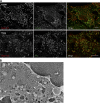Clathrin-containing adhesion complexes
- PMID: 31208994
- PMCID: PMC6605790
- DOI: 10.1083/jcb.201811160
Clathrin-containing adhesion complexes
Abstract
An understanding of the mechanisms whereby cell adhesion complexes (ACs) relay signals bidirectionally across the plasma membrane is necessary to interpret the role of adhesion in regulating migration, differentiation, and growth. A range of AC types has been defined, but to date all have similar compositions and are dependent on a connection to the actin cytoskeleton. Recently, a new class of AC has been reported that normally lacks association with both the cytoskeleton and integrin-associated adhesome components, but is rich in components of the clathrin-mediated endocytosis machinery. The characterization of this new type of adhesion structure, which is emphasized by mitotic cells and cells in long-term culture, identifies a hitherto underappreciated link between the adhesion machinery and clathrin structures at the plasma membrane. While this discovery has implications for how ACs are assembled and disassembled, it raises many other issues. Consequently, to increase awareness within the field, and stimulate research, we explore a number of the most significant questions below.
© 2019 Lock et al.
Figures



References
-
- Akisaka T. 2000. [Ultrastructure of clathrin sheets and cytoskeleton of podosomes on the cytoplasmic side of ventral membranes of cultured osteoclasts]. Kaibogaku Zasshi. 75:381–386. - PubMed
-
- Baschieri F., Dayot S., Elkhatib N., Ly N., Capmany A., Schauer K., Betz T., Vignjevic D.M., Poincloux R., and Montagnac G.. 2018. Frustrated endocytosis controls contractility-independent mechanotransduction at clathrin-coated structures. Nat. Commun. 9:3825 10.1038/s41467-018-06367-y - DOI - PMC - PubMed
Publication types
MeSH terms
Substances
Grants and funding
LinkOut - more resources
Full Text Sources

